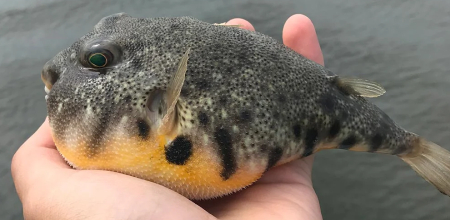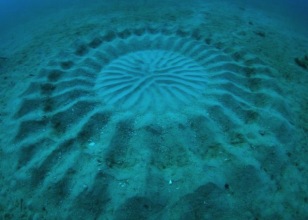 The Pufferfish, also called a Blowfish, has the scientific name Tetraodontidae tetraodontidae, and is the second most poisonous creature in the world. (The first is the Cone snail).  Most Pufferfish are found in tropical and subtropical ocean waters, but a few live in fresh water. In the wild, most live to be about 10 years old. A fully grown Pufferfish can weigh as much as 13 kilograms.
Most Pufferfish are found in tropical and subtropical ocean waters, but a few live in fresh water. In the wild, most live to be about 10 years old. A fully grown Pufferfish can weigh as much as 13 kilograms. Pufferfish use their beaks and teeth to break apart shellfish, including clams, mussels and krill. They also use them to defend against other fish and various types of predators. Because they are covered in poisonous spikes, they have no real natural predators except Tiger sharks, the common octopus, and sea snakes.  Pufferfish are able to inflate into a ball shape to evade predators by making themselves appear much larger than they really are. These clumsy swimmers fill their elastic stomachs with huge amounts of water (and sometimes air) and blow themselves up to several times their normal size. With specially modified gill muscles and a lack of ribs, the fish can swell to an almost spherical shape. Some pufferfish species also have spines on their skin to ward off potential predators.
Pufferfish are able to inflate into a ball shape to evade predators by making themselves appear much larger than they really are. These clumsy swimmers fill their elastic stomachs with huge amounts of water (and sometimes air) and blow themselves up to several times their normal size. With specially modified gill muscles and a lack of ribs, the fish can swell to an almost spherical shape. Some pufferfish species also have spines on their skin to ward off potential predators.

An 'uninflated' Pufferfish  Most Pufferfish also contain a toxic substance that makes them foul tasting and potentially deadly to other fish. The majority of the 206 pufferfish species are toxic, and some of them are among the most poisonous vertebrates in the world. In certain species, the internal organs, such as the liver, and sometimes the skin, contain tetrodotoxin, and as a result are highly toxic to most animals when eaten. There is enough poison (1,000 times more powerful than cyanide) in one pufferfish to kill 30 adult humans. There is no known antidote.
Most Pufferfish also contain a toxic substance that makes them foul tasting and potentially deadly to other fish. The majority of the 206 pufferfish species are toxic, and some of them are among the most poisonous vertebrates in the world. In certain species, the internal organs, such as the liver, and sometimes the skin, contain tetrodotoxin, and as a result are highly toxic to most animals when eaten. There is enough poison (1,000 times more powerful than cyanide) in one pufferfish to kill 30 adult humans. There is no known antidote.
Pufferfish are aggressive fish that are willing to attack anyone or anything they perceive as a threat. Puffers usually live alone and do not usually share their territory with other fish.  The meat of some species is considered a delicacy in Japan. Known as fugu, it must be prepared by specially trained chefs who know which part is safe to eat, and in what quantity. They remove the toxic parts of the fish, such as the liver, gonads and skin.
The meat of some species is considered a delicacy in Japan. Known as fugu, it must be prepared by specially trained chefs who know which part is safe to eat, and in what quantity. They remove the toxic parts of the fish, such as the liver, gonads and skin.In 2007, a doctor in Thailand reported that unscrupulous fish sellers sold puffer meat disguised as salmon, which caused fifteen deaths over three years, with 115 people hospitalized.  The white-spotted Pufferfish was described by David Attenborough as "the greatest artist of the animal kingdom" due to the males' unique habit of wooing females by creating nests in sand composed of complex geometric designs. The males create nests as part of their mating ritual in the sand, measuring 2 metres in diameter. The nests are created to attract mates through the nest's impressive design and ability to gather fine sand particles, both of which influence a female's mate choice.
The white-spotted Pufferfish was described by David Attenborough as "the greatest artist of the animal kingdom" due to the males' unique habit of wooing females by creating nests in sand composed of complex geometric designs. The males create nests as part of their mating ritual in the sand, measuring 2 metres in diameter. The nests are created to attract mates through the nest's impressive design and ability to gather fine sand particles, both of which influence a female's mate choice.
|